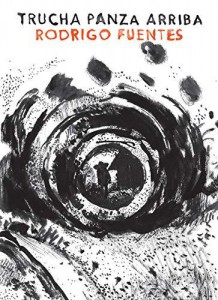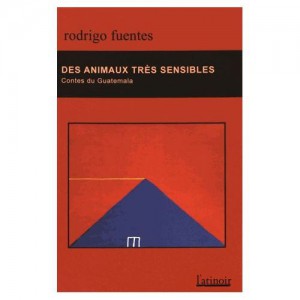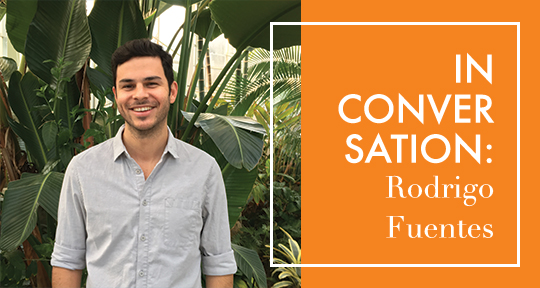In late 2016, the Guatemalan publishing house SOPHOS put out Rodrigo Fuentes’s literary debut, entitled Trucha panza arriba. The book follows, sometimes closely and at other times tangentially, Don Henrik, a white landowner living in Guatemala, and the way his decisions and economic and emotional downfall affect those around him. The book includes intense dramas like “Dive”—available in Asymptote’s Winter 2019 Issue—and “Ubaldo’s Island”; vibrating suspense stories like “Whisky”; and profound character explorations like “Henrik.” And all of them are wrapped in exquisite dialogue, like “Terrace,” my favorite story. I told Rodrigo it was my favorite.
“Really?” Rodrigo said, somehow confused.
“Sí,” I told him, and said it was a tight story. “Apretada,” I said, “elegantly condensed, effective, quick as a flash.”
The first time I interviewed Rodrigo was back in early 2017, when Trucha had just come out to high praise. That interview ended up getting published in the Guatemalan arts and culture magazine, esQuisses. Earlier this month, I translated that text, updated the questions, and added a few more. I also confirmed my initial impression that Rodrigo is an excellent talker. His depth and generosity only added to the fact that his book had enthralled me; his prose, enlightened me; and his characters, abandoned me. Admittedly, I still find myself revisiting passages of Trucha to witness the disperse cohesiveness of the book and see if I can build something similar.
I cannot. At least not yet.
Set in rural Guatemala, Rodrigo’s characters are no strangers to the country’s profound violence, racism, and brutality. The titular Don Henrik and his once thriving business are affected not only by chance and Don Henrik’s own neglect, but also by criminality and the country’s typical turmoil and instability. These are not, however, clichéd representations of the Guatemalan reality. They brim with unique wonder and brilliantly placed and accurate idiosyncrasies, and they are carried along by the characters’ wit and intensity. A type of hypnotic dread is constant throughout the book, and it always seems to lead to tragedy or, at times, even comedy.
Trucha soon gained momentum. It was reissued several times across Latin America, and also translated into French and published by L’atinoir. Trucha was even shortlisted for the prestigious 2018 Premio Hispanoamericano de Cuento Gabriel García Márquez. And lately, Ellen Jones’ beautiful and percussive translation of the book was published by Charco Press as Trout, Belly Up.
Rodrigo’s detailed craft, gripping characters, and tense backdrop make this an entertaining, informing, and disarming read that continues to haunt me to this day.
—Interviewer José García Escobar
José García Escobar (JGE): You wrote most of Trout living abroad, far from Guatemala. What sort of effect did this have on the book? And I’m not talking about improving your skills as a writer (or any of the experiences you went through as a student) but on how you viewed and thought about your country.
Rodrigo Fuentes (RF): Something I paid attention to while living abroad was how people from different countries spoke and expressed themselves. The accent is almost like a country’s ideology: we generally assume ours to be “neutral,” but it reveals a lot about how the person speaking views the world. I look at Guatemala, and it’s a tiny country, but one with very talented narrators. And each region of the country tells stories in different ways. The way people tell stories in the mountains is very different from how people in the eastern part of the country tell them, or those living by the coast, or in the city, undoubtedly; I paid attention to that. I was always interested in the conversations taking place between the city and rural areas. Living abroad allowed me to pay attention to these conversations from a different vantage point, and a character like Henrik enabled me to move back and forth between those two worlds.
JGE: The stories in Trout are all connected. Did you ever think of turning this into a novel? They don’t seem to work together in order to build a bigger plot, but did the idea ever occur to you?
RF: No. The first story I wrote, “La isla de Ubaldo,” I wrote eight years ago, and I’ve written many other stories since. But the ones I ended up including in this collection all belonged to the same universe and orbited around Henrik. I did work on them to make sure they complemented each other well, but the idea of turning this into a novel never crossed my mind.
JGE: So you didn’t write these stories together, or at the same time, and you weren’t even thinking of putting together a book project. Why did you revisit these characters, then?
RF: I grew fond of them, of how they moved, how they talked. But Henrik had a lot to do with this decision. I was interested in seeing how these other characters viewed Henrik and dealt with the world crumbling around him. So it gave me a road to follow, and the chance to look at him from up close and afar.
JGE: This book does not have a definitive ending, and I think there are many loose ends. I’m guessing this book is merely the first layer of a bigger thing, and that these characters might reappear later on. Do you think that your relationship with them is over?
RF: (Laughs). I’m not sure if I’ll go back to them. For this book, I was especially focused on one central character, Henrik, but the secondary characters might reappear somewhere else. I do have other stories that I wrote around that time, and they share similarities.
JGE: Will they be like some of Bolaño’s characters, the ones that appeared suddenly?
RF: Maybe. I imagine there are stubborn characters that do come back unexpectedly. But I have been writing other stories since, and none include the characters found in Trout.
JGE: Can you tell me about the origin of this book?
RF: It all started with the last story of this collection, entitled “Henrik,” which was adapted from the short story that won the Premio Carátula in 2014. Some time after, I started considering the people around Henrik, those who would also be affected by his financial ruin and increasingly vulnerable situation.
JGE: Did these characters become a type of itch for you? Did you want to explore them?
RF: “Gradually, and then suddenly,” Hemingway would say. It wasn’t an immediate thing, but at different points, as I was working on a story, I would realize that some of these characters could have something to say. The people around Henrik are close relatives, friends, employees who work with or for him. Their different perspectives show Henrik in different and sometimes contradictory ways, and that was something I was drawn to.
JGE: When you started working on the stories that are in this book, did you know that these characters were going to return?
RF: Some I did, others I didn’t. But I didn’t have an initial plan.
JGE: Henrik works like the patron saint of this book. Why him? I realize that the foreigner in Guatemala holds a lot of meaning and plays many roles: patron, savior, dictator, supplier; and they’re all just as valid. Did you have one of these roles in mind for him in these stories?
RF: My intention wasn’t to present a “white man” who would fulfill the expectations for that relative position of power. But now that you mention it, Henrik works as a type of trampoline that allowed me to jump back and forth between the two worlds of this book: the urban and the rural. I was interested in the idea of a character that, much like him, could move like a fish in water through both places. At the same time, he’s undergoing a series of predicaments and his relationships with those around him are quickly changing as well. Inevitably, issues of class and race come up in these interactions.
JGE: Many of these stories are clearly character explorations. They are not plot-driven. When you’re writing, do you prefer to follow a character rather than to build a plot?
RF: My writing used to be more plot-driven. I worked hard to create good narrative tension and find a way out of it. [Juan Carlos] Onetti changed that for me. I read some of his stories, stories like “Bienvenido, Bob” in which the main character goes through some brutal transformations in very few pages. Ever since then, I have wanted to focus on characters, and build the tension from someone instead of something. Characters can take on a life of their own as you write them, and that can hold a great amount of interest and suspense for me.
JGE: What happens if, let’s say, you have a story that you want to work on, that you feel has the potential to be plot-driven and is not based on a character? Do you still work around the protagonist, or do you follow the architecture given by the plot you thought about?
RF: Sometimes I do work based on some sort of plan, but plans tend to change; the original path or the destination often become something else. Sometimes, the characters and the story lead me places I hadn’t even thought about going. Given that, I feel more comfortable writing without a clear path.
JGE: Do you like it when the story surprises you?
RF: I do like it when a series of unexpected circumstances changes the plot or characters and modifies the narrative map I had envisioned at the beginning. That’s also part of the excitement I find in writing.
JGE: I know that writers have certain phrases or words that they use frequently, and I found recurrent words in your book. Twice you described light sounds as un hilo—a thread. First, you used it to describe a voice, then a bark. Another one is the word corcel, which appears repeatedly. I’m wondering if these repetitions were meant to keep these stories close to each other, if you used language to unite them. Was this a conscious choice?
RF: The two you mention were lucky shots (laughs), chiripazos, as we say. But, on the other hand, some repetitions are intentional: Henrik’s hands, for example, and how the characters describe them, that was something I focused on consciously.
JGE: This book reminded me of books such as Otro Zoo by Rodrigo Rey Rosa, and Pedro Páramo [by Juan Rulfo] too. Have these authors been close to you as a writer?
RF: Yes, I kept them close, but not for this project. And if we mention Rulfo, I tend to lean towards El Llano en llamas (The Burning Plain). And if you’re talking about influences, I’d mention Carver, Cheever, Hemingway, Chekhov, Onetti.
JGE: For the first edition of Trout, the cover of the book is a piece by Guatemalan artist Francisco Tún. I feel that this painting ties in nicely with the themes of the book. Did you have anything to do with the decision of using this painting?
RF: Yes, I chose it. An important factor was that we—the editorial board and I—knew who owned it, and therefore it was easy to get the rights to use it. But you’re right: I’m very drawn to Tún’s paintings. I like how his characters walk down a road that doesn’t seem to end, one that appears to be incomplete, and that they’re part of an urban landscape that has no limits, no end: a metropolitan area that’s halfway built, and one that leads to nowhere in particular. I thought that would fit the life of these characters.
JGE: And this book has been reissued by many other publishing houses. France’s L’atinoir, Bolivia’s El Cuervo, Colombia’s Libros Laguna, El Salvador’s Los Sin Pisto, and most recently, Scotland’s Charco Press. It’s also forthcoming in Chile’s Libros del Laurel. Do you think that any of these have complemented the book and built a landscape for your characters, much like that original cover? Perhaps they offered something new.
RF: I’ve been happily surprised by the covers of the other editions. In some cases I’ve been involved in the process, and in others I haven’t. By publishing with independent houses, I’ve been lucky to see from up close how talented people work to put together the finest book possible. Every new cover presents a sort of new, visual prologue to the book, and in doing so, colors in novel ways my understanding of the text itself. It’s always an exciting process.


JGE: Are you working on another book project at the moment?
RF: Yes, I’m working on a longer book about family and political change in Guatemala.
Rodrigo Fuentes (1984), of Guatemalan nationality, won the II Premio Centroamericano Carátula for Short Stories (2014). He is the co-founder and editor of the magazine Suelta and of the digital publishing house and literary journal Traviesa. Trucha, panza arriba was a finalist for the 2018 Premio Hispanoamericano de Cuento Gabriel García Márquez, the most prestigious prize awarded to short-story writers in Latin America. It has been published in Guatemala, Bolivia, Colombia, and El Salvador, as well as in France and Scotland.
José García Escobar is a journalist, fiction writer, translator, and former Fulbright scholar from Guatemala. His writing has appeared in The Evergreen Review, Guernica, and The Guardian. He’s Asymptote‘s Editor-at-Large for the Central American region. He works as a journalist with Plaza Pública.
*****
Read more from Spanish-language Authors from the Asymptote Blog:

